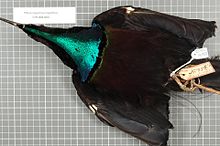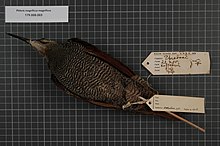| Magnificent riflebird | |
|---|---|

| |
| Male magnificent riflebird perched. | |
| Conservation status | |
 Least Concern (IUCN 3.1) | |
| Scientific classification | |
| Domain: | Eukaryota |
| Kingdom: | Animalia |
| Phylum: | Chordata |
| Class: | Aves |
| Order: | Passeriformes |
| Family: | Paradisaeidae |
| Genus: | Ptiloris |
| Species: | P. magnificus |
| Binomial name | |
| Ptiloris magnificus (Vieillot, 1819) | |
| Synonyms | |
|
Craspedophora magnificus | |
The magnificent riflebird (Ptiloris magnificus) is a species of passerine bird in the birds-of-paradise family Paradisaeidae.
Magnificent riflebirds are widely distributed throughout lowland rainforests of western New Guinea and the northern Cape York Peninsula of Australia (continent). A relatively common species throughout its range, it is evaluated as a species of Least Concern on the IUCN Red List of Threatened Species. It is listed on Appendix II of CITES.
Taxonomy
The magnificent riflebird was formally described in 1819 by the French ornithologist Louis Vieillot under the binomial name Falcinellus magnificus. It is now placed in the genus Ptiloris that was introduced in 1825 by the English naturalist William Swainson. The common name "riflebird" comes from the likeness of their black velvety plumage to the uniform of the British Army Rifle Brigade.

Two subspecies are recognised:
- P. m. alberti Elliot, DG, 1871 – north Cape York Peninsula, Australia
- P. m. magnificus (Vieillot, 1819) – west and central New Guinea
Description
This riflebird is a medium-sized bird, being up to 34 cm long. The male is velvet-black bird-of-paradise with elongated black filamental flank plumes, an iridescent blue-green crown, a wide, triangle-shaped breast shield, and on central tail feathers. It has a black curved bill, yellow mouth, blackish feet and a dark brown iris. The female is brownish with dark spots and buff bars below with a white brow. The immature male resembles the male but with less tail plumes.
Behaviour
The diet of the magnificent riflebird consists mainly of fruits and a variety of invertebrates such as spiders, millipedes, etc. Males are polygamous and perform solitary courtship displays on a 'dancing perch'. During these displays, the male fully extends his wings and raises his tail; he jerks upward while swinging his head from side to side, showing off his metallic blue-green breast shield, and producing a distinctive "woosh" sound as he flaps his wings. Multiple females will observe these displays, and, if satisfied with the performance, reward the male with mating rights. Females subsequently build nests, incubate, brood, and feed young without male assistance.

References
- BirdLife International (2012). "Ptiloris magnificus". IUCN Red List of Threatened Species. 2012. Retrieved 26 November 2013.{{cite iucn}}: old-form url (help)
- Vieillot, Louis Pierre (1819). Nouveau dictionnaire d'histoire naturelle, appliquée aux arts, à l'agriculture, à l'économie rurale et domestique, à la médecine, etc (in French). Vol. 28 (Nouvelle édition ed.). Paris: Deterville. p. 167.
- Swainson, William (1825). "On the characters and natural affinities of several new birds from Australasia; including some observations on the Columbidae". Zoological Journal. 1: 463–484 .
- ^ Gill, Frank; Donsker, David; Rasmussen, Pamela, eds. (January 2022). "Crows, mudnesters, melampittas, Ifrit, birds-of-paradise". IOC World Bird List Version 12.1. International Ornithologists' Union. Retrieved 2 February 2022.
- Fraser, I.; Gray, J. (2013). Australian Bird Name - a complete guide. Collingwood, Victoria, Australia: CSIRO Publishing.
- ^ Frith, C.; Frith, D. (2020). "Magnificent Riflebird (Ptiloris magnificus)". In del Hoyo, J.; Elliott, A.; Sargatal, J.; Christie, D.A.; de Juana, E. (eds.). Handbook of the Birds of the World Alive. Barcelona: Lynx Edicions. doi:10.2173/bow.magrif3.01. S2CID 216388410.
- "Magnificent Riflebird (Lophorina magnifica)". www.hbw.com. doi:10.2173/bow.magrif3.01. S2CID 216388410. Retrieved 2019-10-01.
| Taxon identifiers | |
|---|---|
| Ptiloris magnificus |
|
This Paradisaeidae-related article is a stub. You can help Misplaced Pages by expanding it. |